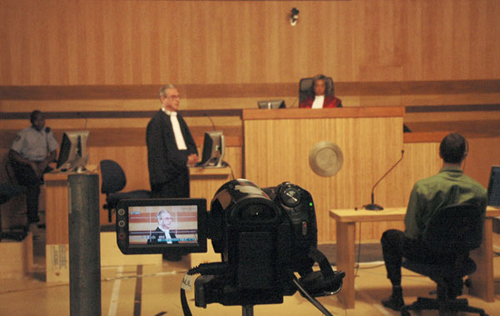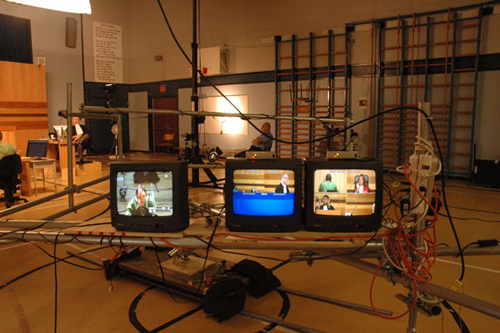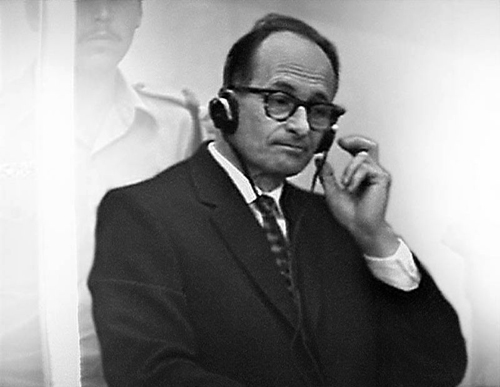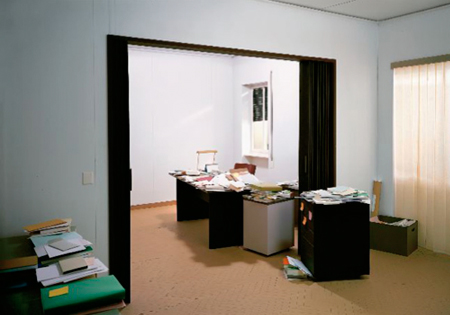

Production stills from Judy Radul, World Rehearsal Court, 2009.
A Thousand Eyes: Media Technology, Law and Aesthetics is an anthology published by Sternberg Press and Henie Onstad Art Center in Oslo, accompanying Judy Radul’s exhibition “World Rehearsal Court.” Radul’s work is a research project into the model of the International Criminal Court, complexly considering the effect technology and new media have had on our justice systems. Her work is a four-hour, seven-channel video installation that includes a courtroom staged and shot in a gymnasium, with a scripted text that takes the forms of vignettes, so that “you never get a whole picture” (Judy Radoul in an interview for Artforum), while including the viewers, who are filmed and projected onto screens that form part of the installation.
Edited by Radoul and Oslo-based curator and art historian Marit Paasche, A Thousand Eyes introduces a different way of discussing the idea of law and the modern justice system in a way that is different than commonplace representation of law and lawmaking in the visual arts. Whereas the form of the trial has been commonly used in artworks, performances, and symposia in the contemporary art world (I am thinking, for example, of Hila Peleg’s film documenting Anton Vidokle and Tirdad Zolghadr’s A Crime Against Art [The Madrid Trial], where the artist and curator put themselves on trial for “collusion with the bourgeoisie and other serious accusations”), the discussion of law and lawmaking in the arts has largely focused on subjects of intellectual property, artistic freedom, and censorship (for example, in Daniel McClean’s (ed.) excellent book The Trials of Art [London: Ridinghouse, 2007]). This book introduces and promotes an intricate web of ways of thinking about the relationship between visual media and the law.
In the introduction to the book, Radoul and Paasche mention the kind of terminology the two worlds share, stating that the “relation of art and law is easily indicated by each discipline’s frequent use of the term “representation” (p. 34). Discussions of the practical uses of technology and the way in which these affect our perception of the legal process in the book vary from the relationship between presentations of justice in art history (in Martin Jay’s study of attributes of justice “Must Justice Be Blind,” for example), through Cornelia Vismann’s analysis of representations of trials in television and film (“Tele-Tribunals: Anatomy of a Medium”), and up to Eyal Sivan’s consideration of the visual effect of the documentation of the Eichmann Trial in Israel in the 1960s.

Still from The Specialist, a documentary about the Eichmann trial by Eyal Sivan, 1999.
In the text accompanying the exhibition of World Rehearsal Court on Henie Onstad’s website, the curator Tone Hansen claims that, “The courtroom has often been compared to the theatre. Given the impact of technology, it is perhaps more appropriate these days to compare it to a TV series.” Television plays a large role in the way a wide audience perceives of legal procedures, but the comparison of the courtroom and the theater is spot on in relation to performativity. And in contemporary society, the performance of the law is conditioned by our image savvy or our visual sensitivities that are the result of exposure to digital media. Thus the editors write in the introduction,
This generative potential of the image exists in artworks, and those who attend to legal themes open the door to broader questions of the image: its potential for both legitimation and lawlessness. In fact, this door has been set ajar by the increasing use of media in the courtroom. The effects of the image on judgment and judgment on the image are constantly calculated (p. 35).
What does it mean to have an anthology of previously published writing as an accompaniment for an exhibition? World Rehearsal Court has had an extensive catalogue printed alongside it when it was staged at the Morris and Helen Belkin Art Gallery at the University of British Columbia, Canada. (The texts from which can be read here.) The anthology—which was printed on the occasion of the Oslo show and a selection of whose writers participated in a symposium, also part of the public programming surrounding the exhibition—promotes a kind of interdisciplinarity that serves to broaden the public’s understanding of the work on view, while providing a fantastic example of what artistic research is and can be.

Thomas Demand, Embassy VI, 2007.
The inspired design of the book also includes about fifty pages of full-color plates of images discussed in the texts included in the book. This use of separate pages for artworks is interesting in its use of the image as both separate and interdependent on the analyses of these works in the texts. It considers images beyond illustration, pushing us to reconsider the way images affect our conception of ethics, morality, and judgment, as the editors state in the aforementioned quotes; to consider the example of the Eichmann trial again, Hannah Arendt had articulated the meaning of it in the past in her book Eichmann in Jerusalem: A Report on the Banality of Evil. What is then left to write about it? To reference its visual impact and the way it shapes our conception of the trial. If looking at visual art trains us to view the power of images and the effects the media has on us more critically, A Thousand Eyes demands the extra leap of considering how our these effects condition our society—and with it, our legal system and understanding of justice.

